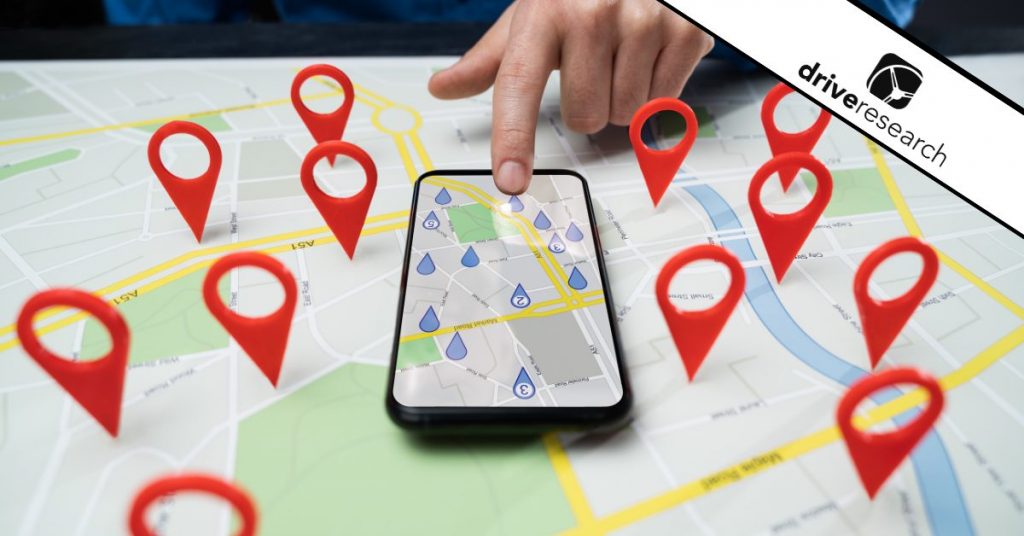
The meteoric rise of mobile device ownership has opened countless doors for market research.
Geofencing surveys, also known as location-based targeting, is one of the most effective applications of mobile devices for conducting market research.
When there is interest in targeting respondents who visit specific locations, a geofencing survey could be the best choice to address research needs.
Wondering if a geofencing survey is right for your business objectives? In this blog post, our market research company will discuss many reasons our clients choose to conduct geofencing surveys in place of in-person methodologies.
What Are Geofencing Surveys?
On a broad scale, geofencing is the creation of virtual boundaries that trigger a pre-programmed action on a mobile device when the device enters or leaves the boundary.
Geofencing surveys involve a market research company creating a virtual boundary around the location being tested. Often, Drive Research conducts these types of studies with retail stores or restaurants.
When a person enters the geofenced area, they are notified to take an online survey. The online survey may ask questions about their shopping experience, their purchasing decisions, what location they are visiting next, and more.
The questions asked in a geofencing survey are designed to answer the objectives of the organization sponsoring the market research study.
Why Geofencing Surveys?
Geofencing surveys are typically used as an alternative approach to in-person intercept interviews.
Customer exit surveys are when professional interviewers are stationed outside or near the exit of a store, event, restaurant, etc. The interviewer asks consumers a variety of questions.
They may be administered on a tablet or clipboard.
Especially in the age of social distancing, geofencing surveys may be a more appropriate or comfortable approach for consumers. In other words, consumers may be more inclined to participate in a survey on their mobile device instead of speaking with a stranger.
Additionally, geofencing surveys can be cost-effective and avoid interviewer bias. Below are some of the best reasons to commission a geofencing survey.
Profile Customers of a Store with Geofencing Surveys
A geofencing survey can be useful for observing the types of individuals visiting a location. It is important to note, respondents will need to have previously opted into a panel or other survey platform for the survey to trigger.
Knowing this, a geofencing effort is best completed across multiple locations to ensure a large enough sample size of respondents.
For example, a regional retail store in the Northeast U.S. might utilize a geofencing survey to create a census of its customers across 30 locations.
A market research company, like Drive Research, has the ability to gather the demographics at both the store level and company level.
The accuracy of the location targeting instills a sense of confidence that the right individuals are receiving the survey. Additionally, completion rates are high due to the relevance of the survey and the inclusion of streamlined questions.
Understand Customer Experience with Geofencing Surveys
The best time to ask about an experience is when it is still top-of-mind. With geofencing, a survey can be pushed to a respondent the second they enter or leave a virtual boundary.
The result is real-time feedback that has less chance of being misstated through a survey indirectly linked to the experience.
Data metrics like frequency of visits and time spent at a location can be automatically collected and offers deeper analysis. Given the mobile nature of geofencing, there is also an opportunity for mobile ethnography.
This could be leveraged in the form of a video open-ended question to capture the experience in the words of the customer.
Learn more about the benefits of mobile ethnography research with this short video.
A geofencing survey can also be a critical part of Customer Experience (CX) research.
For many companies, a customer’s visit to the physical store location is one of the most important touchpoints in the customer journey.
Geofencing has the ability to gain insight on various aspects of a particular location that could only be captured as precisely in person.
React to Advertisements with Geofencing Surveys
Another practical application of a geofencing survey is to understand the effect of marketing stimuli in the real world.
Useful for out-of-home advertising specifically, a geofencing survey can be designed to focus on a specific billboard or public relations event in a city.
If a campaign has scattered the same advertisements across multiple locations, geofencing boundaries can be set up at each area to increase overall response rates.
Individuals who enter a designated area within viewing distance of the advertisement are pushed a survey on their mobile phones.
Having just experienced the advertisement, these respondents can offer earnest reactions to what they have seen.
Looking to Conduct a Geofencing Survey? Contact Drive Research.
Drive Research is a geofencing survey company serving organizations across the United States and beyond. Our geofencing survey company has the partners and expertise to successfully administer the survey and get the results you need.
Questions about an upcoming geofencing survey project? Contact us!



